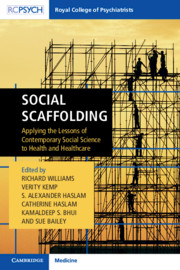Book contents
- Social Scaffolding
- Social Scaffolding
- Copyright page
- Contents
- Contributors
- Foreword
- Note
- Section 1 Schooling
- Section 2 Scoping
- Section 3 Sourcing
- Chapter 15 Crowds and Cooperation
- Chapter 16 Emergencies, Disasters and Risk Reduction: A Microcosm of Social Relationships in Communities
- Chapter 17 Shared Social Identity in Emergencies, Disasters and Conflicts
- Chapter 18 Complex Trauma and Complex Responses to Trauma in the Asylum Context
- Chapter 19 The Mental Health of Veterans: Ticking Time Bomb or Business as Usual?
- Chapter 20 Violent Radicalisation: Relational Roots and Preventive Implications
- Chapter 21 Ways Out of Intractable Conflict
- Chapter 22 Agency as a Source of Recovery and Creativity
- Section 4 Scaffolding
- Section 5 Sustaining
- Index
- References
Chapter 19 - The Mental Health of Veterans: Ticking Time Bomb or Business as Usual?
from Section 3 - Sourcing
Published online by Cambridge University Press: 14 June 2019
- Social Scaffolding
- Social Scaffolding
- Copyright page
- Contents
- Contributors
- Foreword
- Note
- Section 1 Schooling
- Section 2 Scoping
- Section 3 Sourcing
- Chapter 15 Crowds and Cooperation
- Chapter 16 Emergencies, Disasters and Risk Reduction: A Microcosm of Social Relationships in Communities
- Chapter 17 Shared Social Identity in Emergencies, Disasters and Conflicts
- Chapter 18 Complex Trauma and Complex Responses to Trauma in the Asylum Context
- Chapter 19 The Mental Health of Veterans: Ticking Time Bomb or Business as Usual?
- Chapter 20 Violent Radicalisation: Relational Roots and Preventive Implications
- Chapter 21 Ways Out of Intractable Conflict
- Chapter 22 Agency as a Source of Recovery and Creativity
- Section 4 Scaffolding
- Section 5 Sustaining
- Index
- References
Summary
Military personnel operate within the relatively closed environment of the Armed Forces (AF), which has a distinct culture that is broadly separate from the rest of society (Bergman et al., 2014). They are required to carry out duties that may lead to them being injured or killed and, often, the decision about whether to risk one’s life is not in the hands of the individual whose life is being risked. The social bonds between military personnel and their colleagues and their families, and with wider society, are worthy of some scrutiny. There is plenty of evidence that slightly less than 200,000 UK regular and reserve personnel are able to carry out the most arduous and dangerous of duties at least in part because of the close-knit and, in the main, supportive social networks that are characteristic of the AF.
- Type
- Chapter
- Information
- Social ScaffoldingApplying the Lessons of Contemporary Social Science to Health and Healthcare, pp. 172 - 182Publisher: Cambridge University PressPrint publication year: 2019
References
- 1
- Cited by

